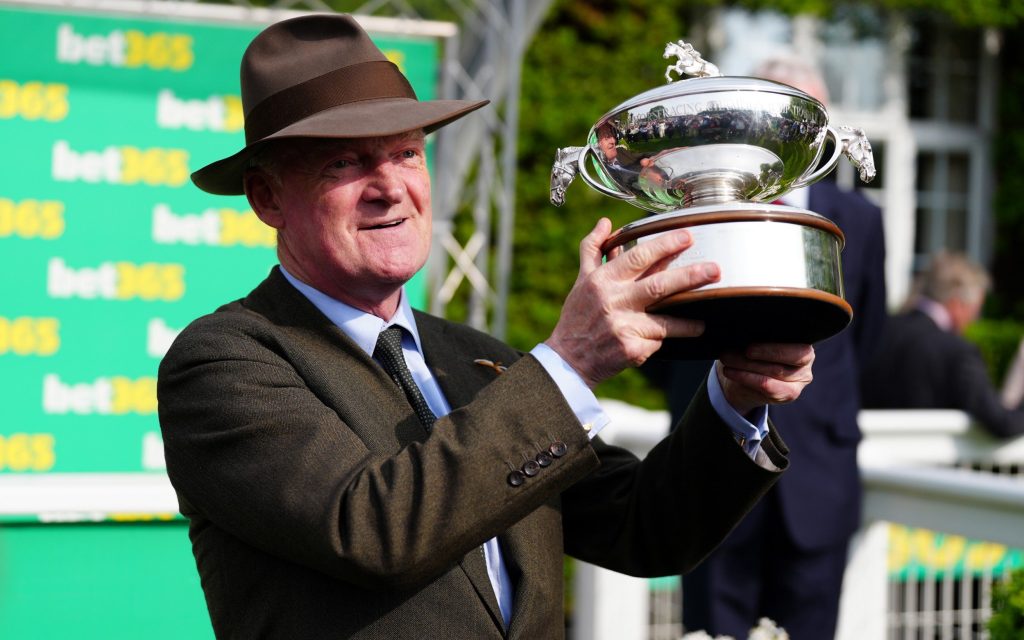
The scrap for the National Hunt trainers’ title between Willie Mullins and Dan Skelton has arguably made this season the most exciting in living memory.
What would normally have been quite low-key meetings turned into incredibly memorable events. Who would have thought that a horse that had been placed at the Cheltenham Festival and been beaten by one-and-three-quarter lengths in the Melbourne Cup would be turning up at Plumpton in April? But that is what happened with Absurde. It was probably the greatest race ever run at the Sussex track. That was their reward for putting up such good prize money.
In the end the endless cohorts of Mullins runners overwhelmed Skelton and his 255-horse cavalry, but the two contrasting protagonists should take huge credit for such a wonderful tussle. The fact that the public warmed to both of them says volumes about them as people.
Mullins, always straight-talking, full of humility and unflustered in defeat. Skelton, the young gun who wears his heart on his sleeve and gives it everything. At no point did it feel like they were putting their own ambition in front of the best interests of their horses.

This had a very different feel to 2004, when Paul Nicholls and Martin Pipe slugged out the title in the dying days of the season like two drunks on a pavement outside a pub.
Reading the hugely respected Timeform’s review of that season brought it all back to me. I quote.
“The RSPCA’s equine consultant David Muir said it was ‘outrageous’ that Commercial Flyer was being asked to race three days in a row…former trainer Charlie Brooks was also vocal, arguing that Sindapour should not have run [at Sandown] less than 24 hours after taking a heavy last-flight fall at Newton Abbot.”
Pipe’s ruthless approach was not sport, it was vanity.
The RSPCA have subsequently become an extreme organisation that one should not take too much notice of, as far as their attitude to racing is concerned, but David Muir was a guy that had a fairly good working relationship with racing.
What this season should have taught us is that there is not much wrong with the structure of the end of the National Hunt season, as long as the challenges of climate change and extreme weather can be accommodated.
Racing’s version of Drive to Survive a triumph
Last week Netflix released their horseracing equivalent of Drive to Survive. It’s a triumph. Totally addictive. You will not be able to step away from the remote before you have binge-watched the entire series.
Race for the Crown is the story of last year’s Triple Crown series: the Kentucky Derby, the Preakness and the Belmont. And it reminds one of the importance of a good narrative in sport.
Like Drive to Survive, Race for the Crown is made by Box to Box Films. Some might say they got lucky with the arrival of Frankie Dettori in California and the prominence of some pretty out-there owners involved in that series – none of whom I would want to train for. But like the Victorian freak shows, they have a certain fascination.
But Box to Box make their own luck. They know what they are looking for to make a show that appeals to a wider audience than any particular sport normally reaches, and they get into the lives of their protagonists.
Like Jeremy Clarkson’s farm series, where he knew exactly what he had found when he stumbled across Kaleb and Gerald Cooper, Box to Box can spot a good human interest story. The people who are good at making these programmes don’t rely on luck.
The only shame, however, was that no grooms feature in Race for the Crown. Their hard work and dedication, their threadbare lives could have provided a poignant contrast to the opulent exhibitionism of the horse owners.
Without giving too much away, there are so many high points in this series. The look in Dettori’s eyes as he leaves hospital after his plane crash, a quarter of a century later, is still chilling. The absurd highs and gut-punching lows of horse racing are uncomfortable to watch. But the brilliance of the camera work and the use of the 1968 Thomas Crown Affair-style split-screen edits work brilliantly.
You will love some of the characters featured in Race for the Crown, and you will hate others. But you will watch to the end, even if you already know the results.

The scrap for the National Hunt trainers’ title between Willie Mullins and Dan Skelton has arguably made this season the most exciting in living memory.
What would normally have been quite low-key meetings turned into incredibly memorable events. Who would have thought that a horse that had been placed at the Cheltenham Festival and been beaten by one-and-three-quarter lengths in the Melbourne Cup would be turning up at Plumpton in April? But that is what happened with Absurde. It was probably the greatest race ever run at the Sussex track. That was their reward for putting up such good prize money.
In the end the endless cohorts of Mullins runners overwhelmed Skelton and his 255-horse cavalry, but the two contrasting protagonists should take huge credit for such a wonderful tussle. The fact that the public warmed to both of them says volumes about them as people.
Mullins, always straight-talking, full of humility and unflustered in defeat. Skelton, the young gun who wears his heart on his sleeve and gives it everything. At no point did it feel like they were putting their own ambition in front of the best interests of their horses.

This had a very different feel to 2004, when Paul Nicholls and Martin Pipe slugged out the title in the dying days of the season like two drunks on a pavement outside a pub.
Reading the hugely respected Timeform’s review of that season brought it all back to me. I quote.
“The RSPCA’s equine consultant David Muir said it was ‘outrageous’ that Commercial Flyer was being asked to race three days in a row…former trainer Charlie Brooks was also vocal, arguing that Sindapour should not have run [at Sandown] less than 24 hours after taking a heavy last-flight fall at Newton Abbot.”
Pipe’s ruthless approach was not sport, it was vanity.
The RSPCA have subsequently become an extreme organisation that one should not take too much notice of, as far as their attitude to racing is concerned, but David Muir was a guy that had a fairly good working relationship with racing.
What this season should have taught us is that there is not much wrong with the structure of the end of the National Hunt season, as long as the challenges of climate change and extreme weather can be accommodated.
Racing’s version of Drive to Survive a triumph
Last week Netflix released their horseracing equivalent of Drive to Survive. It’s a triumph. Totally addictive. You will not be able to step away from the remote before you have binge-watched the entire series.
Race for the Crown is the story of last year’s Triple Crown series: the Kentucky Derby, the Preakness and the Belmont. And it reminds one of the importance of a good narrative in sport.
Like Drive to Survive, Race for the Crown is made by Box to Box Films. Some might say they got lucky with the arrival of Frankie Dettori in California and the prominence of some pretty out-there owners involved in that series – none of whom I would want to train for. But like the Victorian freak shows, they have a certain fascination.
But Box to Box make their own luck. They know what they are looking for to make a show that appeals to a wider audience than any particular sport normally reaches, and they get into the lives of their protagonists.
Like Jeremy Clarkson’s farm series, where he knew exactly what he had found when he stumbled across Kaleb and Gerald Cooper, Box to Box can spot a good human interest story. The people who are good at making these programmes don’t rely on luck.
The only shame, however, was that no grooms feature in Race for the Crown. Their hard work and dedication, their threadbare lives could have provided a poignant contrast to the opulent exhibitionism of the horse owners.
Without giving too much away, there are so many high points in this series. The look in Dettori’s eyes as he leaves hospital after his plane crash, a quarter of a century later, is still chilling. The absurd highs and gut-punching lows of horse racing are uncomfortable to watch. But the brilliance of the camera work and the use of the 1968 Thomas Crown Affair-style split-screen edits work brilliantly.
You will love some of the characters featured in Race for the Crown, and you will hate others. But you will watch to the end, even if you already know the results.












